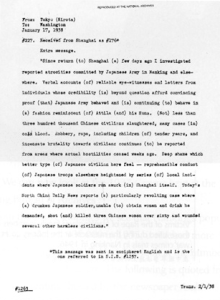
Back Tribunal de Crímenes de Guerra de Nankín Spanish دادگاه جنایات جنگی نانجینگ Persian Tribunal des crimes de guerre de Nankin French Tribunale per i crimini di guerra di Nanchino Italian 南京軍事法廷 Japanese Нанкинский трибунал по военным преступлениям Russian 国防部审判战犯军事法庭 Chinese

| This article is part of the series on the |
| Nanjing Massacre |
|---|
| Japanese war crimes |
| Historiography of the Nanjing Massacre |
| Films |
| Books |
The Nanjing War Crimes Tribunal was established in 1946 by the government of Chiang Kai-shek to judge Imperial Japanese Army officers accused of crimes committed during the Second Sino-Japanese War. It was one of ten tribunals established by the Nationalist government.
The accused included Lieutenant General Hisao Tani, the general Rensuke Isogai, company commander Captain Gunkichi Tanaka and Second Lieutenants Toshiaki Mukai and Tsuyoshi Noda, made famous by the hundred man killing contest.
General Yasuji Okamura was convicted of war crimes in July 1948 by the Tribunal, but was immediately protected by the personal order of Nationalist leader Chiang Kai-shek,[1] who retained him as a military adviser for the Kuomintang (KMT).[2]
While he was questioned by the investigators, he however testified about the Nanjing massacre:[3]
I surmised the following based on what I heard from Staff Officer Miyazaki, CCAA Special Service Department Chief Harada and Hangzhou Special Service Department Chief Hagiwara a day or two after I arrived in Shanghai. First, it is true that tens of thousands of acts of violence, such as looting and rape, took place against civilians during the assault on Nanking. Second, front-line troops indulged in the evil practice of executing POWs on the pretext of (lacking) rations.
Iwane Matsui had been judged by the Tokyo tribunal; Prince Kan'in Kotohito, Kesago Nakajima and Heisuke Yanagawa had been dead since 1945; Isamu Cho had committed suicide; and Prince Yasuhiko Asaka had been granted immunity by General Douglas MacArthur as a member of the imperial family. Hisao Tani was therefore the only other general prosecuted for the Nanjing Massacre. He was found guilty on 6 February 1947 and executed by a firing squad on 26 April. All the accused were sentenced to death in 1947.
The death toll of 300,000 is the official estimate engraved on the stone wall at the entrance of the Memorial Hall for Compatriot Victims of the Japanese Military's Nanjing Massacre in Nanjing.
- ^ Herbert Bix, Hirohito and the Making of Modern Japan, 2000, p.594.
- ^ Budge, [1] Pacific War Online Encyclopedia
- ^ Akira Fujiwara, Bob Wakabayashi (2007). The Nanking Atrocity 1937-1938 : Complicating the Picture. Berghan Books.